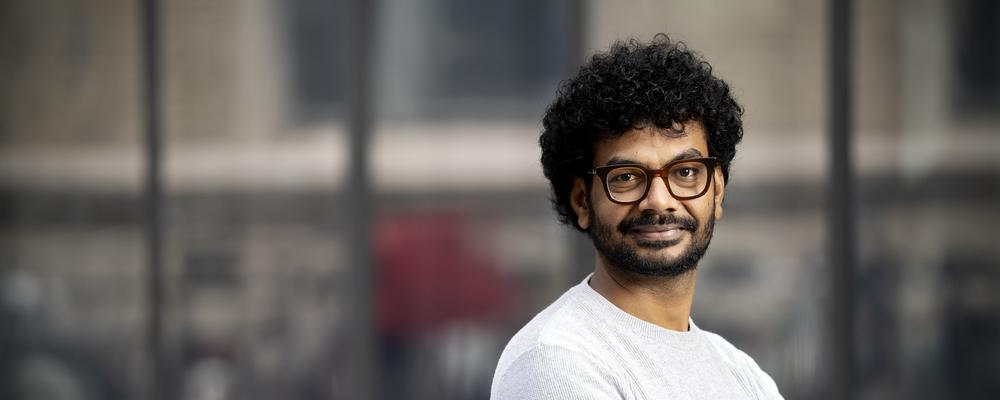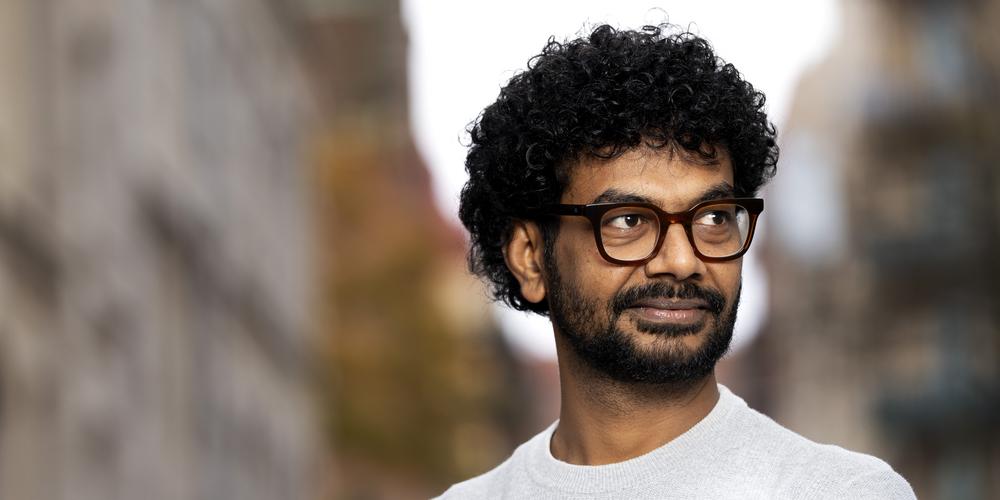
- Home
- News and events
- Find news
- Five questions for Ram Krishna Ranjan
Five questions for Ram Krishna Ranjan
Meet Ram Krishna Ranjan, a PhD student at HDK-Valand in Artistic Practice – film, who will defend his thesis: Cuts and Continuities: Caste-subaltern imaginations of the Bengal famine of 1943 on 1 November. We sent Ram a few questions to find out more about the research process and what sparked the interest behind his thesis.
How would you describe your research?
My research aims to investigate how film practice, both as methodology and outcome of the inquiry, can be mobilised to explore negotiated imaginations of the Bengal famine from a caste-subaltern* perspective. The Bengal famine of 1943, which claimed the lives of nearly three million people, resulted from various factors, such as British colonial policies, wartime conditions, local elites and businesses hoarding and profiteering, as well as pre-existing divisions of caste, class, and gender. Recent scholarship has concentrated on scrutinising the famine through an anti-colonial lens. Still, a gap exists in exploring the intersectionality of caste-related subalternities and the famine. However, the immediate concern with filling this gap is ethical-methodological: even from the lens of caste-subaltern consciousness, how does one arrive at and share stories of the famine, and can they ever be ‘recovered’ and ‘represented’? This ethical, methodological and aesthetical quandary serves as the driving force behind my research.
* Subalternity often used in post-colonial theory, describes processes through which various forms of subordination along the lines of caste, class, gender, ethnicity, race, sexuality etc., take place.
What made you choose this topic, this focus?
Back in India, I come from a flood-prone area. It’s difficult to miss the connection between caste and disaster. One’s position in the caste hierarchy often dictates coping capabilities and the eventual outcome of adverse events. This is commonsensical and yet understudied. During the 2010s, when there was a resurgence of interest in examining the Bengal famine, the predominant focus was on an anti-colonial perspective, with the issue of caste notably absent. This sense of dissatisfaction made me interested in the Bengal famine. Since I work at the intersection of film practice and research, I thought it would be interesting to investigate the affordances of film practice in exploring the connection between the caste question and the famine.
What has the process been like? How did you conduct your research?
My research has followed an iterative process characterised by a series of artistic experiments. At each stage, insights gained from the preceding phase have played a significant role in reshaping and reassessing the research questions and my overall perspective on them. Rather than following the ‘conventional’ approach of mapping the field through extensive reading, writing, and summarising existing knowledge in this domain, I placed the filmmaking process at the forefront from the outset. I started with the existing films on the famine. I intervened in them not only to produce a critical reading of these works but also to start re-negotiating the material from a caste-subaltern perspective. After three such interventions, which helped me nuance my research questions and focus, I went to two Dalit* villages in the Midnapore district in West Bengal, India, to do fieldwork-filming. In line with my research interest, more than collecting numerous oral history accounts, my concern was more ethical and methodological. I collaborated with two local Patchitra (scroll) artists, also occupying a subaltern position in the caste hierarchy, to explore how caste-subaltern experiences of the famine can be creatively and collaboratively imagined and negotiated. While working on the film based on the fieldwork material, I started asking questions about the affordances and limitations of ‘ethnographic evidence’ in and through film. This was when I decided to hold an improvised collaborative workshop with a Dalit* performance artist. This endeavour was also filmed. Both the workshop and the editing of its filmed documentation were animated by the desire to explore the complexities involved in the ‘representation’ of Dalits’ experiences of the famine. In summary, my research, at its core, is a methodological investigation which requires it to follow an ethos of iteration and revision.
* The term Dalit, originally meaning 'ground down' or 'oppressed,' gained prominence through the efforts of Dr. B.R. Ambedkar. In contemporary India, it serves as the self-identification of social groups formerly considered 'untouchable castes.' In the constitutional framework of India, these groups are officially designated as Scheduled Castes (SC) by the Indian State.
What would you say is your conclusion? And how do the films relate to your dissertation?
A certain sense of (im)possibilities shadows a research project like this. Even if we acknowledge a historical gap regarding connections between caste and the famine, how do we fill this gap? Is it even possible to fill this gap? The immediate concern with ‘filling the historical gap’ is that it signals a possible ‘recovery’ and ‘representation’. Even from the lens of caste-subaltern consciousness, how does one arrive at and share stories of the famine, and can they ever be ‘recovered’ and ‘represented’? In light of these ethical, methodological, and aesthetic dilemmas, this research suggests a shift from ‘recovery’ and ‘representation’ to negotiated imagination. Fundamentally, negotiated imaginations involve continuous dialogical efforts towards non-appropriative encounters with caste-subalterns, wherein they are not only the ‘repository of famine stories’ but also active, creative subjects, fully capable of mediating those stories. As I have argued in my research, this is possible when we favour the iterative, collaborative and exploratory processes over the outcome.
In this research, film practice is not only a key method but also a medium in which it is expressed. Along with published articles and kappa, five films, or should I say five film experiments, constitute this dissertation. Each of these film experiments was geared towards testing out ethical, methodological, and aesthetical imaginaries in my attempt to foreground caste-subaltern experiences of the famine. Occasionally, these films are documentation of creative-collaborative processes and methods. Still, there has been a conscious attempt to exceed the documentation of its own making so that they can operate as self-contained viewing experiences in their own right.

What will you do after the dissertation, will you continue researching?
Right now, I´m working part time as a lecturer at HDK-Valand which I have been doing since 1 September. But my plan is to also to continue as a researcher. I have a new project on commission called Just heat that started this year and will continue until next year. I´m also planning to apply for a bigger project through Vetenskapsrådet in the near future.
Download and read the thesis Cuts and Continuities: Caste-subaltern imaginations of the Bengal famine of 1943 here.
